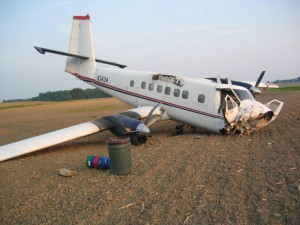The pilot reported that shortly after reaching an altitude of 400 feet agl after takeoff, the engine quit suddenly. He immediately pumped the throttle two times, and turned on the auxiliary fuel pump, but this did not restore engine power. He made a hard forced landing in an industrial park near the airport.
Category: 2005
According to the pilot, she dropped her load of skydivers and was coming in for a landing. She “could see fog rolling in fast” and knew she “had to get…on the ground.” She “landed at a higher speed which is normally fine but because of the runway conditions, which were slick, [she] had minimal braking and ran out of runway.”
The Cessna 182, operating as a platform for skydiving operations, sustained substantial damage during a skydiving flight. The commercial pilot reported a skydiver’s reserve parachute accidentally deployed while the skydiver was getting established on the step before jumping from the airplane.
The airline transport certificated pilot with 10 skydiving passengers began a takeoff in a tailwheel-equipped and turboprop powered airplane on a CFR Part 91 skydiving flight. As the airplane started its climb, the pitch angle of the nose of the airplane increased until the airplane appeared to stall about 50 to 100 feet agl. It descended and impacted the runway in a left wing, nose low attitude.
The airplane took off with its third lift of skydivers for the day. The engine began to run roughly at rotation, and due to the speed of the airplane, and the lack of remaining runway, the pilot elected to continue the takeoff. The pilot initially turned toward a public roadway for a forced landing, but the airplane continued to climb under partial power, so he maneuvered back to the airport for a downwind landing on the runway.
The airplane lost engine power and collided with terrain during the forced landing. Prior to the second flight of the day the pilot fueled the airplane’s right wing with approximately 8 gallons of fuel, bringing the total fuel load for the flight to approximately 20 or 21 gallons. The operator of the skydiving operation said that he instructed his pilots to fuel the aircraft after each flight to 21 gallons for a load of 3 or 4 people, and to 19 gallons for a load of 2 people.
 The purpose of the flight was for the second pilot to perform an evaluation of the first pilot, who was recently designated by the operator as a backup pilot. Following several successful flights with and without passengers, the pilots discussed single engine operations, and the first pilot reduced the right engine’s power to flight idle and feathered the propeller.
The purpose of the flight was for the second pilot to perform an evaluation of the first pilot, who was recently designated by the operator as a backup pilot. Following several successful flights with and without passengers, the pilots discussed single engine operations, and the first pilot reduced the right engine’s power to flight idle and feathered the propeller.
Cessna 206 Fatal (5) Puntarenas, Costa Rica May 31, 2005
http://www.ntsb.gov/ aviationquery/brief.aspx?ev_id=20050608X00728&key=1
The parachute jump plane was substantially damaged when it collided with a parachutist on final approach for landing. The pilot was not able to maintain directional control and the airplane impacted trees and terrain near the airport. The pilot stated that he was on final approach for landing, when a parachutist “made a rapid descent and accelerated from behind [his] right wing.”
Cessna 207 Fatal (4) Tanauan City, Philippines May 08, 2005
http://www.ntsb.gov/ aviationquery/brief.aspx?ev_id=20050608X00734&key=1
Cessna 206 Non-Fatal Klagenfurt, Austria April 30, 2005
http://www.ntsb.gov/ aviationquery/brief.aspx?ev_id=20061027X01566&key=1
The pilot stated that after the 14 jumpers left the airplane at 13,500 feet, southwest of the airport, he started his descent to the northeast. He approached the airport from the northeast overflew the airport, and made a left turn to enter the downwind leg for runway 23. He saw some parachutes on the ground and some in the air.
